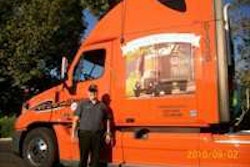The Federal Motor Carrier Safety Administration has amended several of the performance standards in the “Electronic Onboard Recorders for Hours of Service Compliance” final rule, which the agency issued on April 5.
The changes to the final rule were made after FMCSA received petitions for reconsideration from Qualcomm, Xata Corp. and a group of industry stakeholders, including the American Trucking Associations’ Technology & Maintenance Council EOBR Task Force.
Qualcomm and the other stakeholders requested FMCSA reconsider the final rule’s requirements for the temperature range in which EOBRs must be able to operate, and the connector type specified for the USB interface. Xata further requested that FMCSA clarify certain reportable events in the diagnostic table, and consider offering an additional alternative for the data transfer between an EOBR and a roadside safety official’s portable computer.
In the April final rule, FMCSA adopted the EOBR operating temperature range to minus 40 degrees Celsius to 85 degrees Celsius (minus 40 degrees Fahrenheit to 185 degrees Fahrenheit) based on an SAE standard for vehicle electronics. Qualcomm and other stakeholders said the temperature operating range is beyond the range of the leading commercially available systems today.

Qualcomm noted that off-the-shelf telematics and onboard recorder systems are typically designed for minus 20 degrees Celsius to 60 degrees Celsius (minus 4 degrees Fahrenheit to 140 degrees Fahrenheit), and that it would require significant added technical features and costs in such devices to meet the requirements of the new regulation.
In response, FMCSA said it does not intend to require an EOBR be so rugged that it operates at extreme temperatures that realistically will not occur in a truck’s normal operating environment. The agency deleted the requirement for a specific operating temperature range from its final rule.
The final rule originally required a single USB compliant interface featuring a Type B connector, that the USB interface must comply with USB V1.1 and V2.0 USB signaling standards, and implement the Mass Storage class (08h) for software driverless operation.
Xata requested that FMCSA more clearly define the frequency, duration and availability for capture of five EOBR Diagnostic Event Codes that the agency listed in its final EOBR rule. Those codes are Low Voltage (LOWVLT), Battery Low (BATLOW), Communications Error (COMERR), Display Error (DYPERR) and Keyboard Error (KEYERR).
The first two of these diagnostic events could occur during a vehicle’s cold start, but would be resolved when the vehicle is warmed up. The third diagnostic events could occur when a CMV is operating in areas with limited cellular coverage.
FMCSA agreed with Xata for a need to clarify thresholds and frequencies for the diagnostic events that would trigger fault codes for these various conditions. The agency determined it would be more appropriate to consider the fault-code reporting thresholds during the implementation period prior to the June 4, 2012, compliance date of the final rule.









